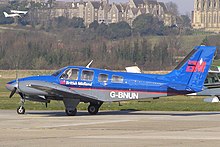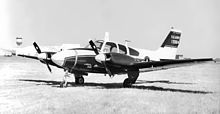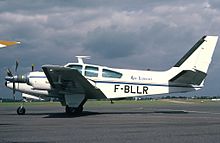Beechcraft Baron
| Baron | |
|---|---|
 | |
| Beechcraft Baron 58P | |
| Role | Civil utility aircraft |
National origin | United States |
| Manufacturer | Beechcraft |
| First flight | February 29, 1960 [1] |
| Status | In production |
| Primary user | United States Army (historical) |
| Produced | 1961–present |
Number built | 6,884+[2] |
Unit cost | US$1.4 million (2017)[3] |
Developed from | Beechcraft Travel Air |
The Beechcraft Baron is a light, twin-engined piston aircraft designed and produced by Beechcraft, introduced in 1961. A development of the Travel Air, it remains in production.
Contents
1 Design and development
2 Variants
2.1 Baron 55
2.2 Baron 56TC
2.3 Baron 58
2.4 T-42A Cochise (95-B55B)
2.5 SFERMA SF-60 Marquis
3 Operators
3.1 Government operators
3.2 Military operators
4 Specifications (B55)
5 See also
5.1 Notes
6 References
6.1 Bibliography
7 External links
Design and development

Cockpit of a 1964 Baron 55 with a mixture of original equipment and modern avionics
The direct predecessor of the Baron was the Beechcraft 95 Travel Air, which incorporated the fuselage of the Bonanza and the tail control surfaces of the T-34 Mentor military trainer. To create the new airplane, the Travel Air's tail was replaced with that of the Beechcraft Debonair, the engine nacelles were streamlined, six-cylinder engines were added, and the aircraft's name was changed. In 1960, the Piper Aztec was introduced, utilizing two, 250 hp Lycoming O-540 engines; Cessna too had improved their 310 with two Continental IO-470 D, producing 260 hp. Meanwhile, Beechcraft's Bonanza had been improved with a Continental IO-470-N, but the answer to competition was to make a true twin engined variant of the Bonanza. The first model, the 55, was powered by two, six-cylinder IO-470-L engines, producing 260 hp at 2,625rpm; it was introduced in 1961. It included the fully swept vertical stabilizer of the Debonair, while still retaining the four to four+five place seating of the Travel Air.[citation needed]
Since its inception, the Baron has always been near the top of the light airplane hierarchy. In 2008 a new Baron costs roughly $1,040,000. As expensive to operate as it is to buy, the 'next step up' from a Baron is a very big one. Faster aircraft, with greater range and more load-carrying capability are generally turbine-powered and far more expensive.[4][5] The older Baron variants, mainly the 55 series, have dropped little in value, with their fair market prices numerically equal to that of their original pricing, in today's dollars.[6]
Variants
Barons come in three basic types: the Baron 55 (short body), Baron 56 (short body) and Baron 58 (long body), with several sub-variants each.
Baron 55

Two Baron 55s flying in formation with a 1980-built B55 nearest. E55 in background.

A 1962 Baron C55 in the factory paint scheme[a]

Beechcraft Model E55 Baron
The early Baron 55, A55 and B55 were fitted with 260 hp (194 kW) Continental IO-470 engines and had gross weights of 4880 to 5100 lb (2,200 to 2,300 kg). These had a typical cruise speed of 190 knots (350 km/h) at 7000 ft (2100 m), and came with 116 or 136 US gallon (440 or 515 L) fuel tanks.[7][8]
The C55, D55 and E55 models had an increased cruise speed of 200 knots (370 km/h) due to the 285 hp (213 kW) Continental IO520s. The gross weights of these later models increased to 5300 lb (2400 kg). They were about a foot (0.3 m) longer than the B55 Barons, and came with 136, 142, or 166 US gallon (515 or 628 L) fuel tanks.[citation needed]
Model 55 Barons were produced from 1961 to 1983, with 3,651 manufactured.[2]
- Model 95-55 Baron
- Baron prototype.
- 55
Introduced 1961. Four to five seat, twin engined transport, powered by two 260-hp Continental IO-470-l six cylinder piston engines. 190 units built. Priced at $58,250.[9]
- A55
Built 1962 through 1963. Four to five seats. Improvements were a new instrument panel, interior, and exterior paint scheme. Priced at $58,950.[10]
- B55
Introduced in 1964, run through 1982. Four to six-seats. New exterior scheme and interior design. A 120 lb (54 kg) increase in gross weight to 5,100 lb (2,313 kg). Priced at $59,950 (1964), $177,500 (1982).[11]
- C55
Built 1966 through 1967. Four to six seats. Powered by two, 285-hp Continental IO-520-C piston engines. Increased performance over the B55. Nose lengthened to accommodate more baggage, avionic equipment, and to improve weight and balance. Crack prone engine air intake box design changed. Alternators changed from belt driven to gear driven. 451 aircraft built. Priced at $68,350 in 1966.[12]
- D55
Built 1968 through 1969. Four to six seats. Introduced new paint scheme and 'speed-slope' windshield. Changed to three blade props and a different flap configuration. 316 aircraft built. Priced at $73,950 in 1968.[13]
- E55
Introduced in 1970, run through 1982. Four to six seats. Incorporated new paint scheme and interior design. Improved avionics and panel. Wing-tip lights and rotating beacon made flush; new entrance step. Also added were 172 US gallon (166 usable) interconnected tanks with one fill cap per wing became an option in 1976. 433 built. Priced at $83,950 in 1970, $219,500 in 1982.
Baron 56TC

An early Baron 56TC seen in-flight.
In 1967, Beechcraft had begun development of a faster, pressurized twin, the Model 60 Duke; the Duke was to go head-to-head with Cessna's 320 Skyknight. The Duke was to use two turbocharged 380-hp Lycoming TIO-541-E1A4 engines, therefore, Beech wanted experience working with, and flying the new engine. The engine was fitted to a modified Baron C55, becoming the 56TC (that prototype, EG-1, was later retired after certification). The results of the 56TC were as planned, it proved a good testbed and experience building model for the Duke's development. However, it was a noticeably loud airplane, especially so for a Beechcraft. Along with its increased noise, the 56TC had an increase in structural strength and thus empty weight to compensate for the higher power. When introduced in 1967, it was the fastest Beech aircraft, rivaling even the early King Airs sold at the time. 93 Baron 56TC aircraft were built between 1967 and 1971,[2] with production ending due to Duke sales and the 1970 introduction of the Baron 58.[citation needed]
- 56TC
- Introduced in 1967, built until the 1969 model year. Four to six seats. Power came from two 380-hp (283-kW) Lycoming TIO-540-E1B4 turbocharged piston engines. Priced at $89,950 in 1967.[14] 82 aircraft sold.[2]
- A56TC
- Introduced 1970, built until 1971. Only model change throughout the 56 production. Featured new exterior paint scheme and interior design, new instrument panel, smooth rotating beacon and navigation lights, nose wheel light. Priced at $101,750 in 1970.[15] 11 manufactured.[2]
Baron 58

The turbocharged 58TC variant.

1980 Baron 58PA of BMI
Introduced for the model year 1969,[16] the larger, more powerful Baron 58 was developed from the Baron 55, introducing club seating, double aft baggage doors, and new gross weight of 5,400 lbs. Depending on the variant, the Baron 58 is fitted with either the Continental IO-520 or IO-550 300-hp engine. The Baron 58 can cruise at 200 knots (370 km/h) at 7000 ft (2100 m). The lengthening of the fuselage increased rear baggage space, as well as providing more comfortable six-place seating over the Baron 55 and 56TC.[citation needed]
In 1976, the turbocharged Baron 58TC and pressurized Baron 58P were introduced. These variants were powered by turbocharged Continental TIO-520s of 310–325 hp (230–240 kW), had an increased 6100–6200 lb (about 2800 kg) gross weight, and were certified under FAR23 with a new type certificate. The Baron 58P/58TC models were capable of cruising at 200 knots (370 km/h) at 8000 ft (2400 m) and 220 knots (410 km/h) at 20000 ft (6100 m), and were typically equipped with 190 US gallon (719 L) fuel tanks.[citation needed]
A big change in panel/system layout on 58/58TC/58P occurred in 1984, including relocating throttle, gear, flap, propeller and mixture controls to industry-standard positions.[citation needed]
Although the turbocharged 58TC/58P variants were discontinued in 1984 and 1985, respectively, the normally aspirated Baron 58 was still in production as of 2015.[17]
The current production version is the G58, featuring a glass cockpit, improved passenger cabin and changes to selected airframe details.[4]
- 58 Baron
- Original variant, introduced in 1969 and run through 2004 (production continued as G58). Four to six seats. Powered by two 285-hp Continental IO-520-C or Continental IO-550-C piston engines.[16] 2,124 aircraft built.[2]
- 58P Baron
- Introduced 1976, run through 1985. Pressurized cabin, powered by two Continental TSIO-520-L turbocharged piston engines. Priced at $200,750 in 1976.[18] 495 produced.[2]
- 58TC Baron
- Introduced in 1976, run through 1984. Turbocharged engines, powered by 310 hp Continental TSIO-520-L engines. First flew October 31, 1975. Priced at $170,750 in 1976.[19] 151 aircraft sold.[2]
- G58 Baron
- Introduced in 2005, currently in production. Version of 58 Baron with Garmin G1000 glass cockpit avionics.[20]
- G58 Baron ISR
- Introduced in 2013, Beechcraft developed a low cost ISTAR aircraft for Fuerzas Unidas de Rapida Acción (FURA), an agency within the Puerto Rico Police Department. In 2014, the aircraft was upgraded with a FLIR 230-HD electro-optical/infrared (EO/IR) camera system, operator’s console that housed the mapping/mission management computer, a recorder, a multi-band communications radio system and data link for special mission operators.[21]
T-42A Cochise (95-B55B)

T-42 Cochise
The T-42A Cochise is a military version of the Baron 95-B55 for use by the United States Army as an instrument training aircraft. The Army Aviation School took delivery of 65 aircraft, a further five were bought for delivery to the Turkish Army.[22]
By 1993, the Army's remaining T-42 aircraft had been transferred to the Army Reserve and the National Guard and were no longer in standard use.
SFERMA SF-60 Marquis

SFERMA 60A Marquis
A twin 530 hp Astazou X turboprop modification of the Baron first flown in 1961, developed from SFERMA's 1960 Astazou IIA turboprop conversion of a Model 95 Travel Air (SFERMA PD-146 Marquis).[23][24][25]
Operators
Government operators
 Argentina
Argentina
Presidential Flight – One Baron 55 temporarily transferred during 1989 from the Junta Nacional de Carnes.[26]
Military operators
 Argentina
Argentina
Argentine Army – One Baron 55 and one 58. Retired in 1983.[27]
 Bolivia
Bolivia
Bolivian Air Force - One as of December 2018.[28]
 Haiti
Haiti
Armed Forces of Haiti[29]
 Mexico
Mexico
Mexican Air Force[30]
Mexican Naval Aviation[31]
 Rhodesia
Rhodesia
Rhodesian Air Force – One aircraft only.[32]
 Spain
Spain
Spanish Air Force[33]
 Turkey
Turkey
Turkish Air Force[34]
Turkish Army[22][34]
 United States
United States
United States Army[22]
Specifications (B55)
Data from Jane's All The World's Aircraft 1976–77 [35]
General characteristics
Crew: 1
Capacity: 5
Length: 28 ft 0 in (8.53 m)
Wingspan: 37 ft 10 in (11.53 m)
Height: 9 ft 7 in (2.92 m)
Wing area: 199.2 ft² (18.50 m²)
Airfoil: NACA 23016.5 at root, NACA 23010.5 at tip
Empty weight: 3,156 lb (1,431 kg)
Max. takeoff weight: 5,100 lb (2,313 kg)
Powerplant: 2 × Continental IO-470-L air-cooled six-cylinder horizontally opposed piston engine, 260 hp (194 kW) each
Performance
Maximum speed: 205 knots (380 km/h, 236 mph) at sea level
Cruise speed: 180 knots (333 km/h, 207 mph) 55% power at 12,000 ft (3,660 m)
Stall speed: 73 knots (135.5 km/h, 84 mph) IAS, power off, wheels and flaps down
Range: 942 nmi (1,746 km, 1,085 miles) 65% power at 10,500 ft (3,200 m), 45 min reserves
Service ceiling: 19,700 ft (6,000 m)
Rate of climb: 1,670 ft/min (8.5 m/s)
See also
Related development
- Beechcraft Bonanza
- Beechcraft Travel Air
- Bay Super V Bonanza
Aircraft of comparable role, configuration and era
- Beechcraft Twin Bonanza
- Cessna 310
- EM-11 Orka
- Piper Seneca
- Let L-200 Morava
Related lists
- List of military aircraft of the United States
Notes
^ Built in 1962 as part of the A55 production it became the prototype C55[2]
References
^ Taylor 1976, p.214.
^ abcdefghi "Beechcraft Serialization - 1945 thru 2017" (PDF). beechcraft.com. Beechcraft Aircraft. 10 September 2018. Retrieved 20 October 2018..mw-parser-output cite.citation{font-style:inherit}.mw-parser-output .citation q{quotes:"""""""'""'"}.mw-parser-output .citation .cs1-lock-free a{background:url("//upload.wikimedia.org/wikipedia/commons/thumb/6/65/Lock-green.svg/9px-Lock-green.svg.png")no-repeat;background-position:right .1em center}.mw-parser-output .citation .cs1-lock-limited a,.mw-parser-output .citation .cs1-lock-registration a{background:url("//upload.wikimedia.org/wikipedia/commons/thumb/d/d6/Lock-gray-alt-2.svg/9px-Lock-gray-alt-2.svg.png")no-repeat;background-position:right .1em center}.mw-parser-output .citation .cs1-lock-subscription a{background:url("//upload.wikimedia.org/wikipedia/commons/thumb/a/aa/Lock-red-alt-2.svg/9px-Lock-red-alt-2.svg.png")no-repeat;background-position:right .1em center}.mw-parser-output .cs1-subscription,.mw-parser-output .cs1-registration{color:#555}.mw-parser-output .cs1-subscription span,.mw-parser-output .cs1-registration span{border-bottom:1px dotted;cursor:help}.mw-parser-output .cs1-ws-icon a{background:url("//upload.wikimedia.org/wikipedia/commons/thumb/4/4c/Wikisource-logo.svg/12px-Wikisource-logo.svg.png")no-repeat;background-position:right .1em center}.mw-parser-output code.cs1-code{color:inherit;background:inherit;border:inherit;padding:inherit}.mw-parser-output .cs1-hidden-error{display:none;font-size:100%}.mw-parser-output .cs1-visible-error{font-size:100%}.mw-parser-output .cs1-maint{display:none;color:#33aa33;margin-left:0.3em}.mw-parser-output .cs1-subscription,.mw-parser-output .cs1-registration,.mw-parser-output .cs1-format{font-size:95%}.mw-parser-output .cs1-kern-left,.mw-parser-output .cs1-kern-wl-left{padding-left:0.2em}.mw-parser-output .cs1-kern-right,.mw-parser-output .cs1-kern-wl-right{padding-right:0.2em}
^ Fred George (May 2017). "2017 Business Airplanes Purchase Planning Handbook" (PDF). Business & Commercial Aviation. Penton. p. 87.
^ ab "Baron G58". Beechcraft. Retrieved July 27, 2017.
^ "King Air C90GTx". Beechcraft. Retrieved July 27, 2017.
^ "Beechcraft Baron". Aircraft Owners and Pilots Association. Retrieved July 27, 2017.
^ Schlaeger, Gerald J. (March 1961). "Pilot Report: Beechcraft Model 55 Baron". Flying. New York, New York: Ziff-Davis. Retrieved October 15, 2014.
^ Collins, Richard L. (July 1973). "Basic Baron". Flying. New York, New York: Ziff-Davis. Retrieved October 15, 2014.
^ Ball 1994, p.54.
^ Ball 1994, p.60.
^ Ball 1994, p.72.
^ Ball 1994, p.165.
^ Ball 1994, p.176.
^ Ball 1994, p.364.
^ Ball 1994, p.383.
^ ab Ball 1994, p.246.
^ Hawker Beechcraft Official Site Archived March 27, 2010, at the Wayback Machine
^ Ball 1994, p.444, 449.
^ Ball 1994, p.395.
^ G58 Pilots Operating Handbook, p. 2-17
^ Beechcraft (July 14, 2014), Beechcraft launches Baron G58 ISR demonstrator tour Archived April 2, 2015, at the Wayback Machine, retrieved January 26, 2015
^ abc Harding 1990, pp. 17–18.
^ Watkins, Peter (August 1961). "Pilot Report: SFERMA's Marquis New Light Twin Turboprop". Flying. Vol. 69 no. 2. pp. 40–41, 76, 78.
^ "France's Aircraft Industry" (PDF). Flight: 846. 17 June 1960.
^ "Salon Extraordinaire" (PDF). Flight: 730. 1 June 1961.
^ Ay, Carlos (June 9, 2014). "The short story of Argentina's military Beechcraft Barons". gacetaeronautica.com. Retrieved July 15, 2018.
^ "The short story of Argentina's military Beechcraft Barons". January 2016. Retrieved January 8, 2016.
^ Hoyle Flight International 4–10 December 2018, p. 40.
^ Wheeler Flight International August 4, 1979, p. 357.
^ Wheeler Flight International August 4, 1979, p. 366.
^ Andrade 1982, p. 137
^ Wheeler Flight International August 4, 1979, p. 386.
^ Wheeler Flight International August 4, 1979, pp. 378–379.
^ ab Wheeler Flight International August 4, 1979, p. 382.
^ Taylor 1976, pp. 214–215.
Bibliography
Baron G58 Pilots Operating Handbook, Doc. No. 58-590000-67, Revision A12 May 27, 2015. Wichita: Beechcraft Corporation- Andrade, John. Militair 1982. London: Aviation Press Limited, 1982.
ISBN 0 907898 01 7
- Ball, Larry A: From Travel Air to Baron...How Beech Created a Classic, Ball Publications, 1994.
ISBN 0-9641514-0-5
- Harding, Stephen. U.S. Army Aircraft Since 1947. Shrewsbury, UK: Airlife Publishing, 1990.
ISBN 1-85310-102-8. - Hoyle, Craig. "World Air Forces Directory". Flight International, 4–10 December 2018. Vol. 194, No. 5665. pp. 32–60.
ISSN 0015-3710.
Taylor, John W. R. Jane's All The World's Aircraft 1976–77. London: Jane's Yearbooks, 1976,
ISBN 0-354-00538-3.- Wheeler, Barry C. "World's Air Forces 1979". Flight International, August 4, 1979. Vol. 116, No. 3672. pp. 333–386.
External links
| Wikimedia Commons has media related to Beechcraft Baron. |
- Official Beechcraft Baron site
- GlobalSecurity.org: T-42 Cochise